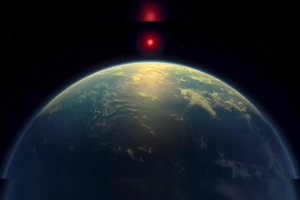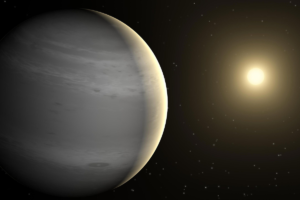Life on Exoplanet K2-18b: Breakthrough Led by Indian Scientist
A Groundbreaking Discovery in the Search for Alien Life
The confirmed detection of life on exoplanet K2-18b may soon shift our understanding of the cosmos. Led by Indian-origin astrophysicist Dr. Nikku Madhusudhan from the University of Cambridge, a scientific team used NASA’s James Webb Space Telescope to detect potential biosignatures on a planet more than 120 light-years from Earth.

How NASA’s Webb Telescope Detected Life-Related Compounds
The James Webb Space Telescope (JWST) uses its infrared instruments to analyze starlight filtered through distant planetary atmospheres. This technique allows scientists to identify the molecular makeup of those atmospheres — including gases like methane (CH₄), carbon dioxide (CO₂), and possibly dimethyl sulfide (DMS), all of which were observed in exoplanet K2-18b’s atmosphere.
What Is Exoplanet K2-18b and Why Is It Special?
Orbiting the red dwarf star K2-18 in the Leo constellation, K2-18b resides in the habitable zone — where temperatures may permit liquid water. This planet is categorized as a sub-Neptune, approximately 2.6 times the radius of Earth and 8.6 times its mass, possibly harboring hydrogen-rich atmospheres and global oceans, favorable for microbial life.
Top exoplanets found in the habitable zone
Hycean Worlds: A New Model for Habitable Planets
Dr. Madhusudhan introduced the Hycean world model — planets with thick hydrogen atmospheres and liquid oceans — broadening the scope of habitability beyond rocky Earth-like planets.
- Hydrogen-dominant atmosphere
- High-pressure liquid oceans
- Stable climate for microbial life
- Biosignature-friendly environments
What are Hycean planets? Learn more
Chemical Signs Supporting Life on Exoplanet K2-18b
Atmospheric Composition Hints at Life-Friendly Conditions
JWST’s NIRISS and NIRSpec instruments revealed:
- Presence of Methane and Carbon Dioxide: Strong indicators of organic or biogeochemical processes.
- Absence of Ammonia: Matches predictions for Hycean environments.
- Possible Dimethyl Sulfide (DMS): A compound produced on Earth solely by biological organisms.
These findings support the idea that life on exoplanet K2-18b may exist, especially in its hypothetical ocean layer.
Who Is Dr. Nikku Madhusudhan?

Dr. Nikku Madhusudhan is a Cambridge-based astrophysicist who has reshaped the search for extraterrestrial life. An alumnus of IIT-BHU and MIT, his work emphasizes extending life detection models to new planet types.
- Institute of Astronomy – University of Cambridge
- Former roles at Yale, Princeton, and MIT
- 2019 MERAC Prize in Theoretical Astrophysics
- Developed Hycean world framework
Is This Definitive Proof of Life on Exoplanet K2-18b?
While the signs are promising, NASA emphasizes that further analysis is necessary. The next cycle of Webb observations aims to verify the presence of DMS and enhance atmospheric models.
“This is the strongest evidence yet there is possibly life out there,” said Dr. Madhusudhan. “We can realistically confirm this signal within one to two years.”
Read about the James Webb Telescope’s previous finds

What’s Next? Ariel Mission and Beyond
The European Space Agency (ESA) is preparing the Ariel mission, launching in 2029, to study exoplanet atmospheres, including K2-18b. This mission will validate current findings and expand the inventory of planets with possible biosignatures.
Future Missions to Strengthen the Search
Multi-Step Strategy Ahead:
- Additional JWST observations
- Ground-based telescope support
- Atmospheric modeling upgrades
- Enhanced spectral libraries for biosignatures
The potential life on exoplanet K2-18b marks an inflection point in space science. With Indian scientist Dr. Madhusudhan at the helm, this study is not just a personal triumph but a global scientific milestone. As next-gen telescopes and missions explore deeper into space, the idea that life exists beyond Earth inches closer to fact than fiction.




